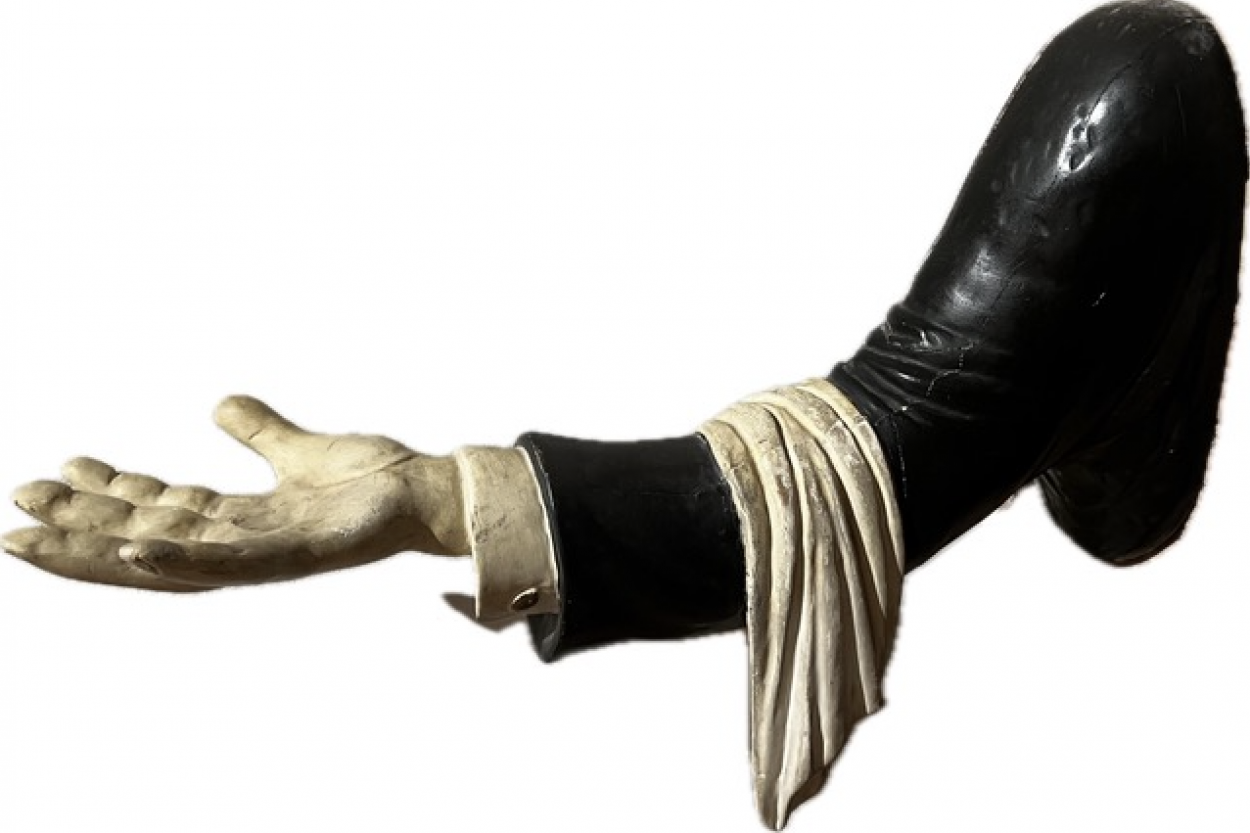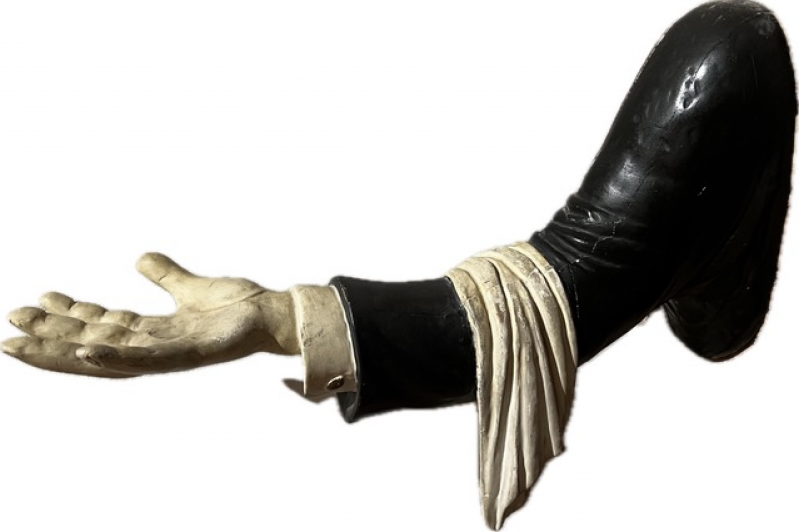True collectors, whether of teacups or tractor seats, are a breed apart, detached from the rest of us by the intensity of their passions. I once knew an older woman who collected manhole covers, dozens of which hung like works of art on the walls of her garage. You couldn't walk with her along the lane without stopping every 500 feet or so while she bent over and peered down.
Your true collectors almost never start out determined to amass as many bottlecaps, bookends, buttons, you name it, as possible. Maybe, like Bruce Howard of Montauk, they had a relative who worked for an airline, which allowed them to fly "I.D. 80," meaning 80 percent off full fare. All over the world, he said, to every continent "except Antarctica." Of course you'd want souvenirs, small ones that fit in your carry-on, and before long you'd realize, as he did, that "every city has its own egg cups. There's no place that doesn't."
Bingo.
How many objects do you have to have before you can call yourself a collector? Maybe five, maybe 50. Maybe, like Mr. Howard, hundreds, not all of them egg cups. Or maybe, like another Montauker, Dan Elliott, 60,000. The Star talked with both men, and a few other hunt-and-gatherers, to hear about the whens, whys, and whats of their collections.
"I once had, oh, 82 roosters," Beth Biondo confessed, laughing, but her house was painted not long ago, and "since then, I've slowed down."
The first rooster arrived in 1986. A neighbor's casual remark began it: "You get up so early, you're like a rooster," she said. After that, it was cock-a-doodle-doo in every corner. "Once I started, everyone gave them to me. Then I started getting big ones, from my mother and my mother-in-law."
Not that she was complaining, not at first anyway, but collectors do often prefer to keep their fancies to themselves. It's been said that "the worst thing you can do is tell somebody you collect something. Then you're inundated." In other words, it's all about what's at the end of the rainbow. The point is to find it for yourself.
Ms. Biondo doesn't stop at roosters. Nutcrackers are another interest. She has about 25 so far, some found at rummage sales, others gifts. They sit up high on window ledges — soldiers, a Santa Claus, a rocking horse, music boxes, and more — so the grandkids can't get at them. Also high up are teacups and Hummel figurines. "I have three collections," she said. "If I started another we'd have to add on to the back of the house."
Mark Donnenfeld used to be in the film business, as a set and production designer. He was 30 or so, he recalled, "doing a commercial out east," when he wandered into an antiques shop run behind their house in Bridgehampton by two women.
"They had a papier-mache chunk of watermelon from a market down South." It was bigger than life — much, much bigger — and it was the genesis of his collection of oversize trade signs, "signs you used to see in stores which would give passers-by an indication of things they sold."
A sheet-metal and wood pistol that came from an upstate gun shop is the largest object in his collection. "It's huge." He also has "a perfect rendition of an old-time razor that could shave a giant, made of metal," and "a giant trowel that looks like it could spread bricks.
In his loft in Manhattan, Mr. Donnenfeld, who heads the Amagansett Library's board of trustees, has "the oversized interior workings of a pocket watch" and a waiter's black-clothed, ramrod-straight arm with pointing finger, signaling the presence of a restaurant. Twenty-two inches long by 17 inches high "to the bottom of the napkin," it dates from 1906. In his house here, there's a life-size Mr. Peanut and a giant ruler, among other enormities.

Collectors have their many happy discoveries, but also their disappointments. Mr. Donnenfeld, for example, has a monster pocket knife, but it wasn't his first choice. "One dealer had a pocket knife made from bone and steel," he recalled. "That was perfect," but someone else got there first. "Mine is wood," he said sadly.
Dan Elliott left this country for the first time in 1978, headed for France. "In Paris, there were postcard racks all over the place." That was the beginning of a collection that now numbers "over 60,000, and that's not a lot in the postcard world."
The subjects of his cards range widely, with innumerable monuments, churches, buildings, and what he described as "local people doing things." Most recently, he has been on the lookout for "non-combat military" activities — soldiers and sailors, mainly from World Wars I and II, engaged in everything but fighting.
"Some people collect battleships," he said. "I find that boring." Instead, the subjects of his current preoccupation are "getting inoculations. Singing, dancing, peeling potatoes. Life on board ship." (Not to mention French children urinating in German helmets.)
Mr. Elliott, who retired a while ago, entered his unusual non-combat cards in a recent contest held by the Metropolitan Postcard Club and won second prize. (Many collectors belong to similar ad hoc clubs, which not only offer a like-minded community but complement their social lives as well.)
"There are two kinds of postcard collectors," Mr. Elliott suggested. "Just locales, and just topics, like hula skirts, jet planes, outrigger canoes." "And," he added after a pause, "they don't see eye to eye."
And where does anyone who doesn't live in a castle keep 60,000 postcards? Simple: "In bins in my garage." It's not perfect, he admitted, "because there's moisture in Montauk, but 60,000 postcards take up less room than 10 Teddy bears. They're all the same size, and they're easy to file."
Rona Klopman, who was raised kosher and has "never eaten pork or bacon in my whole life," collects — wait for it — pigs.
"I was a reading teacher in Jericho in the late '70s when the Muppets came out with Miss Piggy," she explained. "I put up a poster of her, and she became very prominent in the classroom, and the kids would start giving me pig presents. 'There's Miss Piggy's mother,' they'd say."
"Then my own kids got me a copper pig weathervane."
It was on her house in Amagansett, turning with the wind, for decades until last month, when a 50-mile-an-hour gust blew it down.
"I never thought about my pigs as a collection until you asked," Ms. Klopman continued. "I have pig candles. I have pencils with pig heads. I have a pig on my mantel, I found it at HomeGoods. I see anything with a pig, I have to have it."
"By the way, when I got to know Miss Piggy, I decided I would never eat a pig."
Over the past 45 years, Bruce Howard has accumulated hundreds of oil lamps, egg cups, Howdy Doody toys, German beer mugs. Almost everything is in storage now, boxed up in his basement, awaiting a move from Montauk back to a house he owns on Napeague.
The egg cups came first, and there are still more of them than anything else. The ones from Spain are mostly plastic, the Swedish ones are wood, the ones from Holland are Delft, the French are porcelain (Limoges), and there's one hand-painted wooden one from Haiti.
These days, Mr. Howard is deaccessioning. In the fall, when he moves, he'll give away most everything, he said, to friends, acquaintances, relatives. The beer mugs, with knights and castles in 3-D relief representing various German cities, are destined for cousins in Germany. The Howdy Doody dolls — each with 48 freckles, one for each state of the union at the time the children's show went on TV — will go to young nephews and nieces.
"I always liked Howdy as a kid." Mr. Howard said. (Nostalgia, especially where toys are concerned, is known to trigger many collections.)
Mr. Howard, a member of the Hamptons (formerly Living Water) Church in Wainscott, also has "tons of Bibles," often bought at local yard sales. "Half the time, they say, 'Just take it.' "
"I have more Bibles than the Catholic Church," he said. "Russian, French, English. Two are from the 1700s, four from the 1800s." He belongs to a Bible study group, which meets once or twice a week, frequently at his house.
Finally, there's his collection of oil lamps, begun almost 50 years ago when he rented on Napeague. "The electricity would go out a lot, especially in winter, and we'd use oil lamps. The house stunk." Where he lives now, overlooking the ocean, "the sun shoots right in, and the light is so bright that it's burned through the cut glass of an oil lamp and burned the wall."
He used to spend about $65 for a nice lamp, he said, but no more. "I've stopped collecting, except for Bibles. In a pinch, I'll take a Bible anytime."
Walk through the front door of the Montauk Library and the first thing you see, directly opposite you, is a display case. Sometimes filled with old photographs but more often with objects on loan from residents of the hamlet, it's an ever-changing kaleidoscope of curiosities, chosen by collectors from their most loved pieces.
Among her other library tasks, Kathleen Ernst maintains the display case. When people comment about the items, she'll ask them if they're collectors themselves. "Some don't like admitting it, I think," Ms. Ernst said, but most people "are very happy to talk about it," and many agree to put their own treasures on display.
"We've had hurricane lamps, salt-and-pepper shakers, roosters, Royal Doulton jugs, Russian nesting dolls, hurricane lamps, Polish folk art," innumerable china tea cups, and much more.
The display case used to live in the basement of Montauk's old library, until the new building opened in February 2022. Now it has pride of place, and it's clearly Ms. Ernst's pride and joy as well.
"Anyone who has a collection they'd like to share, please come see me!" she said.

